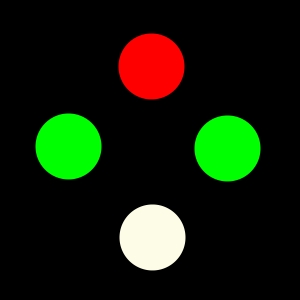For help identifying conditions based on Sensorimotor results and recommending next steps, download our Interpretations and Recommendations Guide, derived from a collection of research and resources.
RightEye Sensorimotor has four components:
- Sensorimotor Screener
- Sensorimotor Exam
- Convergence Insufficiency Symptom Survey (CISS)
- Interpretations and Recommendations
Sensorimotor Screener
Provided upon completion of the RightEye Sensorimotor Screener module, this report gives a PASS/FAIL result based on medical necessity determined by the results of two individual tests and Convergence Insufficiency Symptom Survey (CISS) if taken:
- 9 Point Motor Function - This test measures ocular alignment in multiple fields of gaze by measuring each eye’s location as they look at a red dot placed in all 9 cardinal gaze positions. Red and orange results show inaccurate targeting of points.
- Near Point of Convergence - This test assesses the eyes' ability to work together at near, and measures the distance from a patient's eyes to where both eyes can focus without double vision. Convergence Insufficiency is typically characterized by a break point greater than 4 inches (10 cm) and/or recovery point less than 5 inches (12 cm).

Sensorimotor Exam
Provided upon completion of the RightEye Sensorimotor Exam module. This report shows results for three individual tests and provides an interactive 'Interpretations and Recommendations' form to record findings and recommended next steps.
- 9 Point Motor Function - This test measures ocular alignment in multiple fields of gaze by measuring each eye’s location as they look at a red dot placed in all 9 cardinal gaze positions.

- Cardinal Gaze Position - This test measures how long it takes the eye to travel in different directions and issues are typically characterized by slow speed in relation to the reference range.

- Four Dot Fusion - This test determines whether patients are using both eyes simultaneously and in a coordinated manner. A patient with normal binocular single vision will see four lights.

Convergence Insufficiency Symptom Survey (CISS)
The Convergence Insufficiency Symptom Survey (CISS) is a questionnaire used as both an assessment tool and an outcome measure in treatment of convergence insufficiency. The survey is scored on a 5-point scale with 0='never' and 4='always'.
Interpretations and Recommendations
This interactive report is provided upon completion of the RightEye Sensorimotor Exam. Here you can record your findings, select conditions, and recommend next steps. This can be done on your VisionTracker2 system or accessed any time on your RightEye Dashboard.

Sensorimotor Report Metrics
The following metrics make up the Sensorimotor Report.
-
Distance Between your Eyes (mm)
-
This is calculated using x and y coordinates provided by the eye tracker (which keeps track of the relative pupil locations) when the stimulus is centered on the screen. The distance of the user’s left and right eye is measured, taking into consideration the distance the user’s eyes are from the screen, using the Euclidean distance.
-
- Disparity Between Eyes (D) for all 9 calibration points
- This is the average distance between the left eye (light blue dot) and right eye (dark blue dot) points of gaze on the screen.
- This is represented in diopters.
- Displacement (D) for all 9 calibration points
- Horizontal and Vertical Displacement are measured for both eyes. This is reported as two numbers:
- Distance between the left eye and the target calibration point, horizontal and vertical
- Distance between the right eye and the target calibration point, horizontal and vertical.
- This is represented in diopters.
- Horizontal and Vertical Displacement are measured for both eyes. This is reported as two numbers:
- Pupil Diameter (mm): is calculated as the average size of the pupil when the stimuli is centered on the screen. Pupil diameter is reported as average.